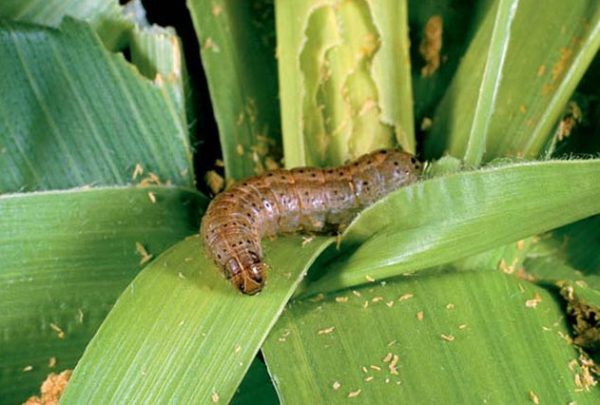The Fall armyworm is a caterpillar, a member of the Lepidopteran family, that feeds in large numbers on a wide variety of plant species, but its favourite food is maize. This caterpillar is native to tropical and sub-tropical regions of the America, but since 2016, it has been spotted across the African continent, munching on maize crops. Farmers were caught unaware – unsure of how to deal with this new pest, resulting in the rapid spread of Fall armyworm from field to field and region to region, leading to great concern about the economic damage is leaves in its wake.

Farmers are on the frontlines facing this pest, as they pick through their plants looking for this caterpillar with an upside-down Y-shaped marking on the head or masses of more than 150 eggs, which are often found on the surface of leaves.
Ugandan farmers have a good resource in this effort to minimize the damage caused by Fall armyworm: The United Nation’s Food and Agriculture Organization (FAO) is working in collaboration with Farm Radio International, Kiryandongo District Local Government and the Ministry of Agriculture, Animal Industry and Fisheries. Using both interactive radio and Farmer Field Schools, they have been raising awareness about this new pest and support farmers to identify and manage it. The success, according to Andrew Atingi of FAO-Uganda), has been in the experiential learning and ecosystem-based methodology which has strengthened the resilience of rural populations.
With the Farmer Field School approach, farmers take the lead in data collection through a Fall armyworm early warning system (FAMEWS). They are supported by sub-county agricultural extension workers using smartphones and farmer radio programs.
Five Farmer Field Schools – with a total of 162 farmers – participated in this project working in five different sub-counties. Extension workers and Farm Radio staff visited these groups to encourage them to listen to the radio as a group to learn about and discuss the techniques for controlling the Fall armyworm. Radio Kitara Masindi aired 30-minute programs on Monday nights (8.00 – 8.30 pm) and repeats on Friday mornings (10.00 – 10.30 am) over six weeks to give farmers the information they needed to monitor their fields for Fall armyworm, including how to identify and manage the Fall armyworm.
Each Farmer Field School was given a radio handset capable of recording a live program. Two group members were selected to take care of the radio set on behalf of the group and farmers were encouraged to listen to the program that was created for them. The live programs were recorded and replayed during group meetings. Farmers had the opportunity to discuss amongst themselves, and to even share their views with other farmers by either calling in directly during the live program or participating by beeping a toll-free line and they are called back (Beep4Voice approach).
The Farmer Field School groups also established one-acre gardens where they planted maize. Group members weeded and monitored their field for the Fall armyworm. They also deployed pheromone traps to trap male moths. FAO provided the five Farmer Field Schools with smartphones for reporting on field scouting findings on a daily basis using the app called FAMEWS.
Every week, a presenter of the farmer’s program visited the farmer groups and interviewed the members about the week’s topic. Their views on successes and challenges were recorded and later played on the program, enabling fellow farmers elsewhere to learn from them. This approach motivated other members in the community to join the already-established groups and also raised the self-esteem of members.
The radio program about Fall armyworm enabled the Farmer Field School members to scout and manage the Fall armyworm pest because they practiced what they learned on the radio. Due to the successful management of Fall armyworm, maize production has increased but the farmers now face the challenge of marketing due to very poor transport and storage facilities.
The group members are also bound together by saving and credit schemes, as well as written regulations that guide them on different aspects like leadership, policies, and social participation. Each group is composed of males and females, youth and elderly having common interests and sharing similar social norms. They do all activities as a group, including scouting and monitoring of Fall armyworm in the fields of group members and discuss management measures as a group.
Group members have been encouraged to share what they have learned as well. Farmer Field School leaders take the radio handsets to other community gatherings and request a few minutes for them to play the recorded radio programs. This has helped them achieve good results in managing Fall armyworm as a community.
Mr. Atingi is happy with the result of the project, which ends in December 2019. “In the context of climate change, the experiential learning and ecosystem-based parts of the FFS methodology have provided the thrust in strengthening the resilience of rural populations and agricultural production systems”, he says.

